Cracks and scratches on your ATV plastics are bound to happen sooner or later. You could maintain and clean your ATV after every use, and still, you’ll end up with faded or scratched up plastic eventually.
To some people, scuffed up plastic on their quad is not a big deal. I mean, it’s not like it affects performance, handling, or anything important anyways. But there’s just something about the way it makes the machine look that I don’t like. So I went ahead and found the best ways to fix some of the most common ATV plastic damage you’ll encounter.
It’s a good idea to know why plastic fades to help you understand why the methods here work for restoring faded plastic. Basically, plastic starts to look faded because the oils in the plastic evaporate over time. The evaporation of oils in the plastic is sped up when the plastic sits in the sun for long periods of time.
Plastic is made from refined oil, and as the oil in the top layer of the plastic evaporates, the plastic is weakened and looks faded. Your plastics become more prone to cracks too the more you let it fade and weaken.
You could simply sand down the top layer of plastic, until you get to the part where the oil hasn’t evaporated yet. Then buff it out until it looks nice and new. But with this approach, you’re still weakening the plastic because you are actually removing layers of the plastic each time you do this.
Another method I’ve tried, is using a heat gun to help bring the oil in the plastic to the surface. This does work pretty good and makes the plastic look nice. But again, you’re not actually restoring oil to the plastic so over time, the plastic is getting weaker and weaker.
My preferred method, and what I recommend you try first. Is to get this Premium Plastic Restorer From Car Guys found here on Amazon. This way you’re not removing plastic, oil, or anything else from your ATV parts. In fact, this stuff is actually adding additives to the plastic to help get them to the condition they were in when they were brand new. This particular plastic restorer also has some nice UV protection to help keep the plastic from drying out and fading in the future.
This particular plastic restorer also has some nice UV protection to help keep the plastic from drying out and fading in the future.
Keep in mind, this is not to repair scratches or anything like that. It is specifically to restore dry faded plastic. There are some other brands out there that will do the same thing, I’ve just had the most luck with this one. To be honest, this is way easier than sanding or using a heat gun anyway, and I don’t have to worry about the structural integrity of the plastic being compromised.
There are two types of scratches you’ll encounter most often, light scratches or deep scratches. Light scratches are the ones caused by branches or bushes hitting the plastics and leaving little visible marks. A lot of people don’t even bother with these types of scratches, and just chalk it up to wear and tear. But for someone spending a lot of money on a quad or ATV, I can understand wanting to remove even the littlest of scratches.
The best way I’ve found for removing light scratches is to go with some 1500 Grit Wet Sandpaper. Just use the sand paper over the areas with scratches and buff it out when you’re done. You could finish up with a coat of the plastic restorer I talked about above to make it look brand new.
Using wet sand paper could even work for medium to deep scratches, but I don’t like removing that much plastic from my ATV parts. For the deeper scratches you end up having to start with 400 grit or worse, and work your way up to 1500 grit to get a smooth surface. For me, it’s not worth all the time and energy sanding to just end up compromising the integrity of the plastics. Don’t forget, the more plastic you sand away, the easier they will crack.
So for deeper scratches I’ll use a plastic bonder/filler. My go-to is this JB Weld Plastic Bonder Gap Filler found here on Amazon. I’ll use this to actually just fill the scratches. It’s pretty easy to use, you push out some of the goop from each tube.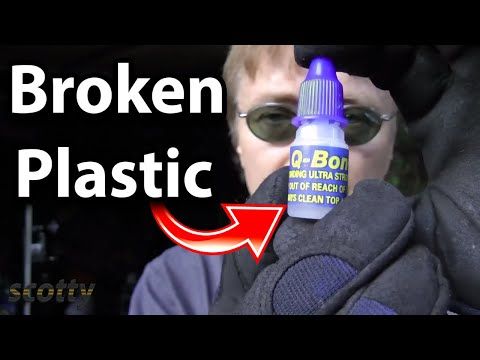 It’s a 1 to 1 ratio and comes out at the same time. Mix it together and fill the deep scratches with it. The stuff sets in about 15 – 20 mins and you can sand it down after a half hour.
It’s a 1 to 1 ratio and comes out at the same time. Mix it together and fill the deep scratches with it. The stuff sets in about 15 – 20 mins and you can sand it down after a half hour.
If you use a putty knife to clean off the excess after filling the scratch, it makes the sanding after much easier. This does set in a black color, so if you don’t want to have to paint afterwards, don’t use this method. I don’t paint after, and I don’t mind having the black filler here and there on the plastics. It’s better than having deep gouges in your plastics just asking to be cracked.
If you haven’t taken care of your ATV plastics, they could dry out over time and eventually crack and break. Or the more likely option, you hit something didn’t you? That’s ok, cracked plastics can usually be fixed without too much trouble. If you don’t want to spend the money buying new plastic parts, you’ll need to do it yourself.
For small little cracks you could try using the JB Weld I talked about above, but that only really works for cracks less than a few inches. But, you probably really messed your toy up bad, and for that, you’re gonna need something better.
But, you probably really messed your toy up bad, and for that, you’re gonna need something better.
I recommend using what’s called a hot staple gun. Like this Astro 7600 Hot Staple Gun Kit found here on Amazon. This thing is amazing and I’ve used it on more than just my ATV. It works by heating up these specially designed staples it comes with. The staples get set into the plastic making a nice strong bond, but still allowing the plastic to be flexible.
You just line up the pieces you want joined, and use the staple gun to staple them together. The staple is heated to it can sink into the plastic a bit, making a super strong bond. I always do the stapling on the underside of the plastic, that way you don’t see the staples. If you use this method, you will still see the crack on the upper side of the plastics. You can then use the JB Weld to fill in the crack, and then sand away any excess making a nice smooth surface.
Sometimes a piece of plastic from an ATV gets bent but doesn’t crack. That’s good, you don’t have to repair any cracked plastics now. But it can leave a discolored looking area on the plastic that doesn’t look right.
That’s good, you don’t have to repair any cracked plastics now. But it can leave a discolored looking area on the plastic that doesn’t look right.
For fixes like this, I like to use a heat gun. It’s really kinda cool how well it works, you can watch the plastic change color as you hold the heat gun to it. Be careful though, too much heat can melt the plastics and there’s no coming back from that. Hold the heat gun a few inches away from the plastic and keep it moving side to side the whole time.
Any old heat gun will work for something like this. Heck, I’ve seen people use a propane torch with success. If you’re unsure what type of heat gun to use, check this Heat Gun from Amazon for starters.
That’s all there is to it. If you want to paint your ATV plastics a new color, check out this article: How To Prep And Paint ATV Plastics.
Sharing is caring!
Since ATVs invest the majority of their time outdoors, their plastic body ends up being discolored from the sunlight's rays, as well as surging around in dirt, mud, snow, and also water does not help. Plastics get messed up by boots or passing particles, and also splits can appear in the body or windshield.
Plastics get messed up by boots or passing particles, and also splits can appear in the body or windshield.
There are a few choices for restoring your ATV's faded plastic so it appears like a showroom model once more. These alternatives differ in price as well as problem.
In this guide, we clarify exactly how to make your ATV resemble new. We provide you with some suggestions on exactly how to restore ATV plastic.
Table of Contents
Now that you understand what creates your ATV plastic to fade allow's take a look at the various ways you can recover your vehicle to its previous glory.
When it concerns restoring your ATV, there are many methods that can be made use of to take on discolored plastic, with everyone delivering different outcomes. So to help you at the same time, we have actually detailed the various techniques down below.
Before you restore your ATV plastic, you should keep your ATV clear.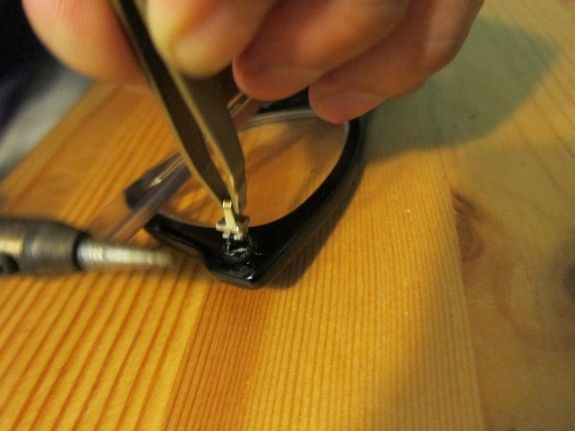 Wash the ATV completely using Dawn dishwashing fluid. Dawn helps get rid of oils and grease from the surface area. And afterward, completely dry the maker totally. If there are scratches, you will also require to sand its plastic surface.
Wash the ATV completely using Dawn dishwashing fluid. Dawn helps get rid of oils and grease from the surface area. And afterward, completely dry the maker totally. If there are scratches, you will also require to sand its plastic surface.
Linseed oil can recover discolored plastic, however, it takes ages to dry. You need boiled linseed oil, rather. Note-- this does not imply you steam the linseed oil on your own! It implies that the linseed oil has actually been pre-treated to completely dry faster.
To speed up points along, choose boiled linseed oil and mix it with paint thinner. We advise a 40/60 proportion of linseed oil as well as paint thinner.
Begin by cleaning your ATV extensively. For best results, you'll intend to eliminate the rack as well as any other parts of the device that are covering the plastics.
Apply the mix to your plastics using a completely dry cloth. You'll discover the linseed oil will remove the oxidization that's causing fading. After you have actually used the blend to all the plastic, allow it a full day to dry.
You'll discover the linseed oil will remove the oxidization that's causing fading. After you have actually used the blend to all the plastic, allow it a full day to dry.
If you maintain your ATV covered and do not use it on a daily basis, this restore will certainly last for a couple of months. If you continuously use your ATV outdoors, this treatment might be called for to be done again in 4-6 weeks.
The following video shows you how to restore ATV plastic with boiled linseed oil.
There are plenty of products in stores that declare to recover plastic. One of the most preferred is Solution Finish and CAR GUYS Plastic Restorer.
A look through customer testimonials shows that they work. How much time the remediation lasts differs from item to item, and just how well you protect your ATV. Yet most appear to last for a number of months.
When using a certain restorer, inspect the instructions of the application on the label. Also, the majority of these items are likewise helpful for plastic. If your ATV seat has a plastic cover, you can make use of these restorers to reverse fading.
First, you should remove the skid plates and racks. If they are drastically damaged whatsoever, you might intend to replace them totally. To enhance your better-looking new plastics, you may intend to strip or sand your racks and repaint them with a spray-on bed liner.
Next up, offer the ATV a good clean overall. Now, it's time to prepare the plastic for waxing. This means fining sand the plastic with fine sandpaper, working your way up from the lowest amount of sandpaper to the highest. You can also use an oscillating device to quicken the process. Make certain you're wearing risk-free gloves, and finish up by fining sand with steel wool.
Use a vinyl flooring liquid wax to the plastic using a car and truck wax applicator. Using thin layers, you can service one area of the plastic while one more section dries. You will need to apply a number of coats, and polish the plastic after each application.
After the last layer is full and also bone dry, end up with an automotive wax for an added layer of luster.
This process is more complex than linseed oil and paints thinner restoration, but it usually has longer-lasting results.
This is the debatable one that we don't advise. It works such as this: you set the heat gun to the lowest setting and blow it a few inches away from the plastic, moving slowly over the discolored areas.
This approach generates instant outcomes. The faded plastic instantly appears new and also glossy.
While it functions, how it works is the issue. The heat partially thaws the top layer of the plastic, making it show up new.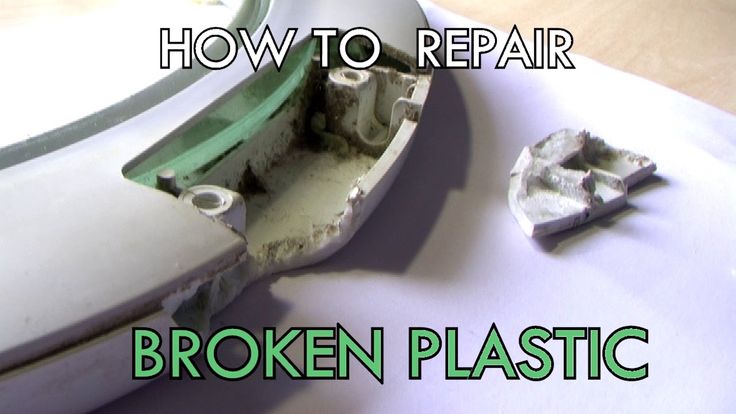
Comparable to various other plastic restore methods, the heat gun method does not last forever. Oxidation as well as fading will certainly return after a number of weeks or months. So you need to duplicate the treatment.
The trouble is that every time you use a heat gun, the plastic gets more brittle as well as more probable to crack as you set about your riding.
So we do not suggest making use of a heat gun. Use linseed oil or a plastic restorer. If you want long-term remediation, see the last method below. You can watch the following video to learn how to restore ATV plastic with the heat gun.
For the last approach, we are going to go over; we have selected an option that is arguably one of the most efficient when it comes to restoring ATV plastic. If you see that your ATV has actually begun to discolor, you can constantly battle the issue by repainting it.
You can do this by using spray paints ideal for ATV plastic, although you will need to apply a primer coat and a safety top layer for the best outcomes.
Like the majority of recovering approaches, paint is not permanent as well as will certainly start to fade with time. Nevertheless, it can last much longer than various other repair choices and can be quickly reapplied whenever the plastic begins to discolor.
If you want to learn more about paint, you can click here to get a guide for painting your ATV step-by-step.
Broken plastic is a little bit a lot more challenging to fix. If a piece of the plastic has come off, not simply a basic fracture, you may be much better off changing the whole plastic part.
However, if it's just a crack, there's hope. We discovered numerous feasible means to repair broken ATV plastic. Nonetheless, most of them, such as using epoxy or superglue do not work well. As quickly as you go out with the ATV once again, the sealed cracks are then loosened
The solution that appears to work ideal is melting the plastic. You can use a plastic welder, heat gun, soldering iron, or some other source of heat to melt the plastic along the crack. You'll require to apply stress on both sides of the plastic up until the melted plastic remedies and holds.
You can use a plastic welder, heat gun, soldering iron, or some other source of heat to melt the plastic along the crack. You'll require to apply stress on both sides of the plastic up until the melted plastic remedies and holds.
For larger fractures, you may need to thaw an exterior plastic to fill the fracture. You can also get plastic welding rods or reinforcement plastic mesh.
When it comes to the windshield, because it is likely acrylic, an acrylic solvent concrete or an acrylic adhesive is the best option.
Adhere to the directions on the label. Keep in mind to clean the windshield before using any item.
Plastic burs very easy as well as wet fining sand will prevent that. With the 180 grit just sand the actually bad areas as well as get the deep scratches, nothing even more. After they have gone away, Use 220 on the overall vehicle. Sand up until the shade is also all over and the scratches are gone.
Sand up until the shade is also all over and the scratches are gone.
Brightening with Toothpaste or Sodium Bicarbonate Toothpaste and baking soda are both light abrasives that you can make use of to brighten plastic. For deeply etched or blemished plastic, capture non-gel toothpaste straight onto the surface and also buff it in a circular movement with a microfiber or cotton cloth.
WD-40 Multi-use product is excellent for most plastic surfaces that have actually had a great deal of exterior direct exposure, so it's great for garden furniture. It is very important to note that Polycarbonate and clear polystyrene plastics are among the very few surfaces where WD-40 multi-purpose products can be avoided.
The very best method I have actually located for removing light scrapes is to choose some 1500 Grit Wet Sandpaper. Just utilize the sandpaper over the locations with scrapes and also enthusiast it out when you're done. You can end up with a coat of the plastic restorer I discussed above to make it look new.
Just utilize the sandpaper over the locations with scrapes and also enthusiast it out when you're done. You can end up with a coat of the plastic restorer I discussed above to make it look new.
To restore the shine, apply a small amount of plastic or metal polish just enough to cover the dull areas, then apply it in a circular motion with a clean, dry cloth. You may need to repeat the process a few times, but eventually, the plastic will shine like new again.
The Most Comprehensive Motorcycle Camping Gear Checklist (Ultimate guide for you)
Rodney L Herron
Rodney L is a technical writer and product consultant with over a decade of experience in the motor industry. Rodney is a fan of performance machines that run fast and loud and an expert in all things custom. His numerous articles and write-ups are available at our knowledge base. Whether it’s something wrong with your motorcycle or you are building a custom bike, you can trust Rodney’s experience.
Many modern motorcycles are replete with plastic panels, they are needed to create a complete look of the bike, improve aerodynamics and protect important components. In order to protect these parts from damage, modern polymers are made flexible and impact resistant, but even this does not save the motorcycle from falls and accidents. In such cases, the manufacturer offers to replace the part with a new one, which costs a lot of money. We have prepared several affordable options for how to make plastic on a motorcycle with your own hands.
First of all, it is necessary to determine the degree of damage. With the proper approach, it is possible to restore a completely broken part, but sometimes it will cost at the level of buying a new one. If the damage is relatively minor and relates to a structure that does not carry a critical load, such as part of the body of a motorcycle (maxi scooters), then cosmetic repair methods are suitable.
Cracks, chips and gluing together several pieces of plastic can be done using hot air soldering or a soldering iron. Responsible, load-bearing structures, as well as parts with a high degree of damage, are best repaired using methods that involve restoring the mass of a plastic part and its characteristics (stiffness, elasticity, etc.). In cases where plastic can no longer be repaired with a patch or gluing, there is an option to detail from scratch. To do this, you will need to carefully study the entire modeling process, have a lot of summary time and nerves. Often, in such cases, it is easier to purchase a used spare part and repair or even buy new plastic.
To repair the plastic of a motorcycle with heated air, you will need a building hair dryer, but not any, but with a temperature controller. You can use the cheapest device, but then there is a risk of overheating the plastic, which will lead to the loss of its basic properties. Overheated material will be brittle and may break under the vibrations from driving on normal roads. You will also need a special nozzle with a thin nozzle, about 5-8 mm.
Overheated material will be brittle and may break under the vibrations from driving on normal roads. You will also need a special nozzle with a thin nozzle, about 5-8 mm.
In addition to the hair dryer, you will need a large piece of plastic identical to the one being welded. To do this, you should pay attention to the marks of the part, most likely you will have a product of the PP, RA or ABS brands in front of you. Polypropylene PP, for example, melts at 300 degrees, and starts to burn at 350, so it should be welded at a temperature of 300 - 340 degrees. Polyamide or PA should be welded at 410 - 460 degrees, ABS at 360 - 400.
Soldering process:
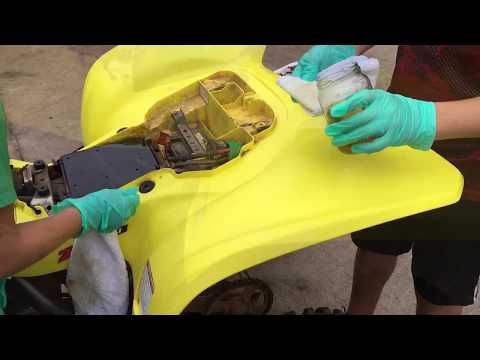 Otherwise, if you weld the parts one by one, some sections may be twisted and it will be impossible to achieve a flat surface without leveling with additional materials.
Otherwise, if you weld the parts one by one, some sections may be twisted and it will be impossible to achieve a flat surface without leveling with additional materials. Advice. If the plastic twists a lot initially, then for ease of working with it, you can fasten it with brackets.
 If you did everything right, then the inner seam will give the piece of plastic enough rigidity, so the outer repair will be rather cosmetic in nature. The process itself looks identical, with the exception of the solder strip, which should be made thinner. After the welding of the front part is completed, the plastic should be cleaned, and if necessary, apply a paint layer on it or hide the error with a sticker that suits the style.
If you did everything right, then the inner seam will give the piece of plastic enough rigidity, so the outer repair will be rather cosmetic in nature. The process itself looks identical, with the exception of the solder strip, which should be made thinner. After the welding of the front part is completed, the plastic should be cleaned, and if necessary, apply a paint layer on it or hide the error with a sticker that suits the style. Such a repair of motorcycle plastic with your own hands is practically no different from the previous one. The main difference will be the tool used. You will need a high power soldering iron that you don't mind getting dirty. The type of material to be welded and the appropriate solder are also important here. The latter can be found in the form of special tapes in stores.
Welding process:
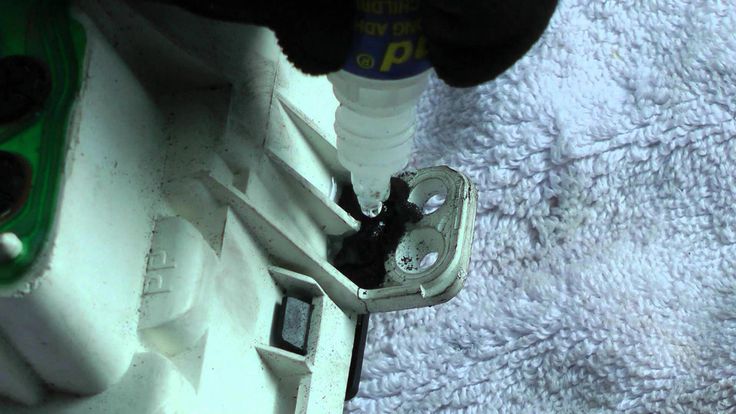
Advice. With proper skill, you can simultaneously make a hollow and fill it with solder.
So the process will take much longer and require more concentration, but the layers of plastic will hold on better, which means that the connection will be more durable. If you did everything right, then in the end you will get a strong seam that looks rough on the inside, but with the outer one is almost perfectly even. This can be achieved due to the deep penetration of the mass during the formation of the recess.
This can be achieved due to the deep penetration of the mass during the formation of the recess.
Note! Some advise using reinforced metal mesh to strengthen. This option only makes sense if you are working with fragile low quality material that is not able to bend.
Motorcycle plastic repair can be done by gluing parts together.
For this we need:
Bonding process: First of all, we remove the defective part, thoroughly wash it with hot water, then clean the areas around the cracks and the ends of the chips, and finally degrease the treated parts. Next, we dilute the resin with a hardener, keep in mind that the material will keep in a plastic state for 2-4 hours, so it is better to cook it in small parts. If you add a little castor oil to the mixture, it will turn out to be more ductile, which is especially important for flexible plastics. The finished resin, on the inside of the part, is applied with a brush in one layer. Next, we put a layer of fiberglass with a width of not more than 5 cm and cover it with another layer of glue. In total, 3-5 layers of mesh should be obtained, and the final layer is glue. Remember! All work with epoxy resin should be carried out with gloves and goggles. Upon completion of work, the part is left to dry for a day, at room temperature. A sign of the hardening of the material is the absence of adhesion and the strength of the structure. You can press lightly on the seam to test its strength and to make sure the material has set. If everything suits, the repair is completed, otherwise we completely remove the layer and apply a new one. There is still the outer part, but it should be treated with putty to prevent damage and then painted over. Gluing is needed to create a strong base, and the final work is best done with more workable materials.
The finished resin, on the inside of the part, is applied with a brush in one layer. Next, we put a layer of fiberglass with a width of not more than 5 cm and cover it with another layer of glue. In total, 3-5 layers of mesh should be obtained, and the final layer is glue. Remember! All work with epoxy resin should be carried out with gloves and goggles. Upon completion of work, the part is left to dry for a day, at room temperature. A sign of the hardening of the material is the absence of adhesion and the strength of the structure. You can press lightly on the seam to test its strength and to make sure the material has set. If everything suits, the repair is completed, otherwise we completely remove the layer and apply a new one. There is still the outer part, but it should be treated with putty to prevent damage and then painted over. Gluing is needed to create a strong base, and the final work is best done with more workable materials.
Speaking of motorcycle plastic restoration, do not forget about the complete replacement of missing or damaged parts. Here we divide the process into making the panel from scratch and making the missing piece. The hardest part is making the part yourself. It is possible to completely repeat the factory forms only from fiberglass. The process is very long, not the cheapest and suitable only for enthusiasts. Initially, you should make a matrix that repeats the shape of the future part. A layer of fiberglass and resin is gradually applied to the matrix, thereby forming the part. Then the product is sanded, primed and painted. Such a detail will last exactly until the next incident, because fiberglass is very fragile, and its repair does not make sense due to the loss of rigidity of the entire structure. Finally, plastic repair can be done with a piece of plastic of suitable composition and size. From the workpiece, you should cut out a shape that repeats the missing part. The method is suitable for straight sections and with a slight spherical bend. A bend can be obtained by heating the part, shaping it and fixing it until it cools.
Here we divide the process into making the panel from scratch and making the missing piece. The hardest part is making the part yourself. It is possible to completely repeat the factory forms only from fiberglass. The process is very long, not the cheapest and suitable only for enthusiasts. Initially, you should make a matrix that repeats the shape of the future part. A layer of fiberglass and resin is gradually applied to the matrix, thereby forming the part. Then the product is sanded, primed and painted. Such a detail will last exactly until the next incident, because fiberglass is very fragile, and its repair does not make sense due to the loss of rigidity of the entire structure. Finally, plastic repair can be done with a piece of plastic of suitable composition and size. From the workpiece, you should cut out a shape that repeats the missing part. The method is suitable for straight sections and with a slight spherical bend. A bend can be obtained by heating the part, shaping it and fixing it until it cools.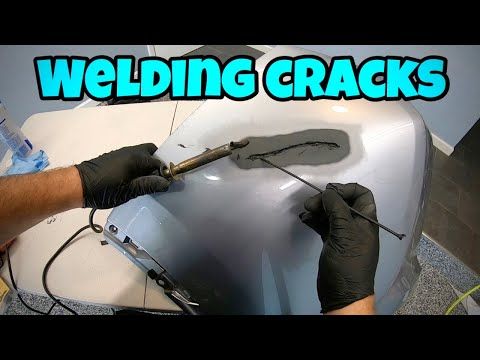
| RemPlast is a center for professional repair and welding of plastic products in Moscow, Moscow region and regions. | specialist call: daily from 9-00 to 20-00 without breaks and days off
|
We repair plastic products of almost any brands, plastic products of various shapes and configurations.
Plastic breakage is a fairly common problem these days. Many plastic products crack, break and become unusable during operation. Plastic welding, or as this process is also called, plastic soldering, will help in restoring broken parts.
Pike plastic - a process requiring thorough preparation, specialist experience and proper assessment of the repairs of the product. If you do not follow all the features of the technology, then the seam will turn out to be brittle and will not withstand even minor loads.
If you do not follow all the features of the technology, then the seam will turn out to be brittle and will not withstand even minor loads.
How to repair a plastic part? There are several methods for welding. One of them is hot air bar welding. For each repaired product, a certain welding temperature is selected, otherwise the surfaces simply will not grab each other. Correctly selected temperature is not the main thing in repair, you need to carefully prepare the surface, cut the edges in a special way and clean the surface.
There are several ways to repair a crack in plastic. To determine the technology of welding plastic, you need to know the nature of the damage and the material of the plastic. Soldering a crack in plastic can take anywhere from 1 to several hours. The process of welding a plastic product must take place in strict accordance with temperature and other factors, it is rather problematic to repair the plastic yourself, it is possible to overheat the plastic part and make it unrepairable.